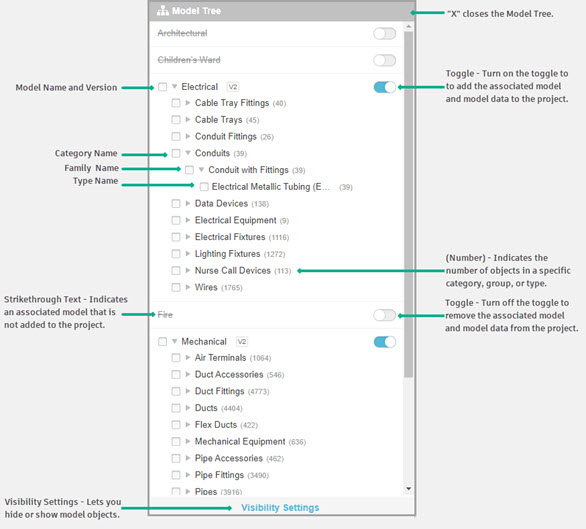Model Tree
The Model Tree lets you view all the models and model data associated with a project. It is also where you add an associated model to a project, or remove an associated model from a project.
Each model in the Model Tree is organized by Category, Family, and Type. A Visibility Setting at the bottom of the Model Tree gives you the option to hide or show specific models by selecting a category.
Instances are not available for selection in the Model Tree, but you can still display one. To display an instance in the Model Tree, select it from the Inventory or the Model Viewer.

Add an Associated Model to a Project
In the Model Tree, turn on the toggle next to the associated model  that you want to add to your project.
that you want to add to your project.
- The model name in the Model Tree no longer appears with
Strikethroughtext. - Both the Inventory and Model Viewer automatically update to include data from the associated model.
Remove an Associated Model from a Project
In the Model Tree, turn off the toggle next to the associated model  that you do not want to add to your project.
that you do not want to add to your project.
- The model name in the Model Tree now appears with
Strikethroughtext. - Both the Inventory and Model Viewer automatically update to remove data from the associated model.
Select Objects and Change Visibility from the Model Tree
- Select an object or multiple objects from the Model Tree. The Selection Bar appears with a quantity summary of the objects selected (or item count for multi-category selection) and your selection displays in both the Model Inventory (highlighted in yellow) and the Model Viewer (highlighted in blue).
- Click Change Visibility in the Selection Bar.
- Select either Hide Selection or Hide Others from the Selection Bar to take action on the items selected. Unhide Selection will only be active if the objects selected are currently not added to the project (as indicated by a text strikethrough).
Notes Regarding the Model Tree
- Excel imports will not update instances for models that are toggled off.
- Models that are toggled off will still be visible in the "Alignment" panel.
- Model Tree is arranged by Models > Categories > Families > Types.
- CAD models are arranged by Models > Categories > Types. Family Name is not valid for CAD models.
Multi-Model Views
Recommended Model Count
Assemble is designed to support fewer than 50 models per view, with fewer than 30 recommended for optimal performance. At higher numbers, users will experience very long load times regardless of the file size of the models.
Model Alignment
To ensure proper alignment of model origins, models should be published to Assemble from a single Navisworks file, where proper alignment has already been achieved. When models are published from separate Navisworks, AutoCAD, or Revit instances, the models will be misaligned in Assemble. Assemble provides a basic Model Alignment tool that can help to fix any translation issues after publish has completed.
Multi-Model Visibility Rules
Filtering rules can be applied to multiple models in a view. However, only a small subset of common model properties (guaranteed to be available for all models) will be visible when using a multi-model rule. For the complete list of model properties, individual model rules must be created instead.
